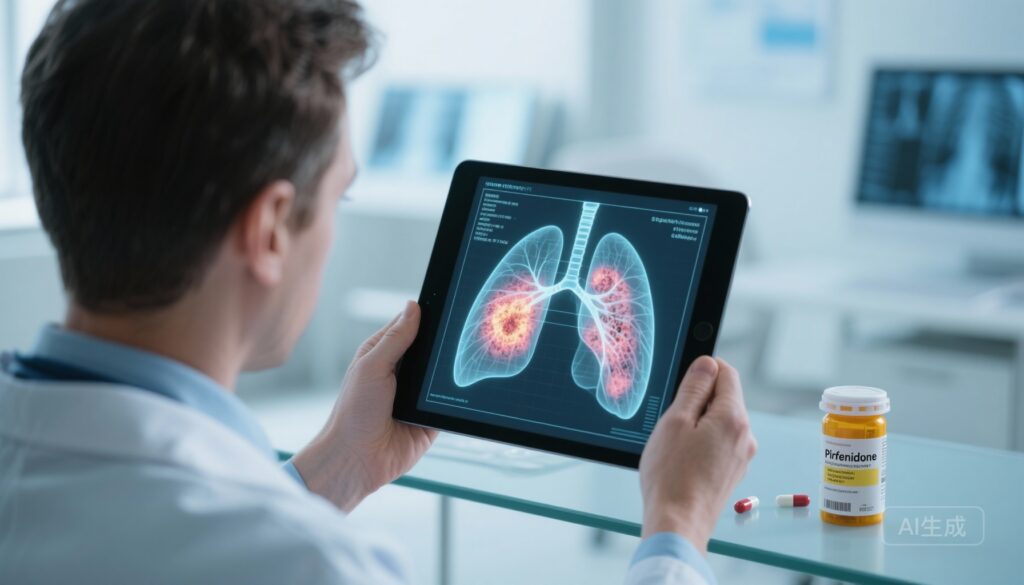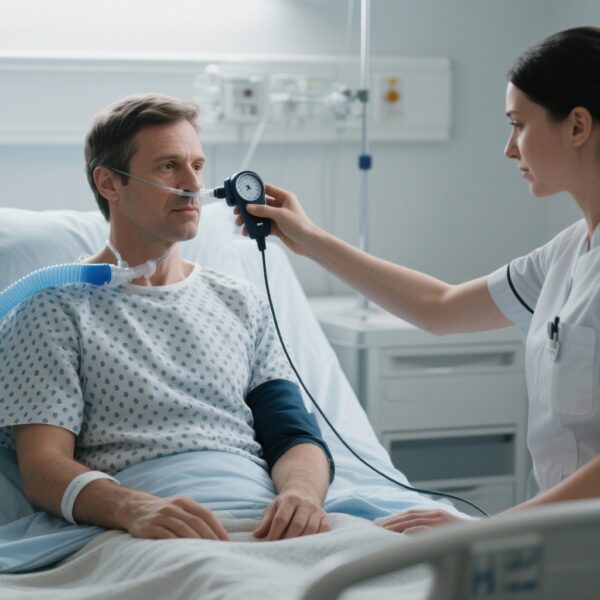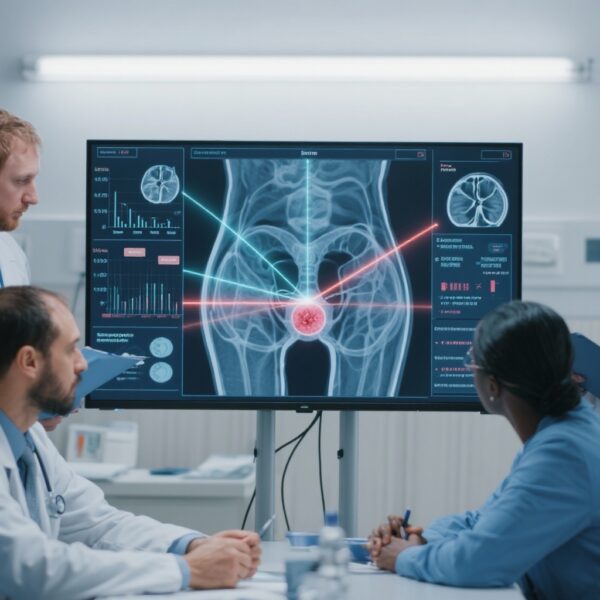Highlights
– In a multicentre, open‑label, randomised phase 2 trial (N=134), pirfenidone plus glucocorticoids improved DLCO% by 8.0% at 24 weeks versus a 2.4% decline with steroids alone (LS mean difference 10.4%, 95% CI 4.3–16.5; p=0.0010).
– The combination showed a comparable serious adverse event profile to steroids alone; pneumonia was numerically less frequent in the pirfenidone arm (6% vs 12%). No treatment‑related deaths were reported.
– Findings support antifibrotic therapy as a promising strategy for moderate radiation‑induced lung injury but require phase 3 validation and assessment in more severe cases and diverse populations.
Background: clinical context and unmet need
Radiation‑induced lung injury (RILI), encompassing acute radiation pneumonitis and subsequent radiation fibrosis, remains a key dose‑limiting toxicity of thoracic radiotherapy. Symptomatic RILI affects quality of life, may necessitate hospitalization, and can interrupt or limit curative radiotherapy delivery. Current management of symptomatic RILI is largely empiric and centered on systemic glucocorticoids, oxygen support and symptomatic measures; however, long‑term prevention of fibrotic progression is an unmet need.
Pirfenidone is an oral antifibrotic with anti‑inflammatory and anti‑transforming growth factor‑beta (TGF‑β) effects that is licensed in many regions for idiopathic pulmonary fibrosis (IPF). Its pharmacologic profile suggests potential to attenuate fibrotic remodelling after lung injury. Prior antifibrotic trials focused on IPF, and evidence for their use in RILI has been limited to small studies and case series. The trial by Hou et al. investigated whether adding pirfenidone to standard glucocorticoid therapy improves lung function in patients with grade 2 or 3 RILI.
Study design and population
This was a multicentre, open‑label, randomised, phase 2 trial conducted across ten centres in China (ClinicalTrials.gov NCT03902509). Inclusion criteria were adults aged 18–75 years with Eastern Cooperative Oncology Group (ECOG) performance status 0–2 and a diagnosis of grade 2 or grade 3 radiation‑induced lung injury per CTCAE v5.0. Patients were randomised 1:1 by a computer‑generated table to pirfenidone plus glucocorticoids versus glucocorticoids alone.
Pirfenidone dosing started at 200 mg three times daily in week 1, 300 mg three times daily in week 2, and 400 mg three times daily from weeks 3–24. Both arms received oral glucocorticoids equivalent to prednisone 40 mg/day in divided doses for 2 weeks, then tapered by 10 mg every 2 weeks over 6–8 weeks. The primary endpoint was change in percentage predicted diffusing capacity of the lung for carbon monoxide (DLCO%) from baseline to week 24, assessed in a modified intention‑to‑treat population. Safety was analysed in all patients who received at least one dose of study treatment.
Key findings
Between November 29, 2021 and December 4, 2023, 134 patients were enrolled and randomised (67 per group). The cohort was predominantly male (78%) and the median follow‑up was 9.2 months (IQR 6.3–16.0).
Primary outcome
At week 24 the pirfenidone plus glucocorticoids group demonstrated an 8.0% improvement in DLCO% from baseline, whereas the glucocorticoids‑only group had a 2.4% decline. The least squares mean difference was 10.4% (95% CI 4.3–16.5; p=0.0010), indicating a statistically and likely clinically meaningful benefit in gas transfer capacity attributable to pirfenidone when added to standard steroid therapy.
Secondary and safety outcomes
Safety profiles were generally comparable between groups. Most common grade ≥3 adverse events included pneumonia (4/67 [6%] in the pirfenidone arm vs 8/67 [12%] in control) and rash (2/67 [3%] in the pirfenidone arm vs none in control). Serious adverse events occurred in 12 (18%) patients receiving pirfenidone and 11 (16%) patients in the control arm. Importantly, there were no treatment‑related deaths. These data indicate manageable toxicity for the combination strategy in this population, although ongoing vigilance for infection remains important given concomitant glucocorticoid use.
Interpretation and clinical implications
Hou and colleagues provide the first multicentre randomised evidence that an antifibrotic agent can improve pulmonary gas transfer in patients with symptomatic moderate RILI when combined with standard glucocorticoid therapy. Improvement in DLCO% at 24 weeks suggests attenuation of parenchymal injury and/or fibrotic progression, a clinically relevant outcome because DLCO correlates with symptoms, exercise capacity and long‑term prognosis in many lung diseases.
If confirmed in larger, placebo‑controlled phase 3 trials, adding pirfenidone to early management of grade 2–3 RILI could transform care by reducing the incidence or severity of persistent radiation fibrosis, improving respiratory function, and potentially permitting more aggressive thoracic radiotherapy regimens by mitigating late pulmonary toxicity. However, several caveats are important when interpreting these results.
Study strengths
– Multicentre randomised design increases internal validity and reduces single‑centre bias.
– Objective physiologic primary endpoint (DLCO%) that is relevant to patient function and prognosis.
– Pragmatic co‑administration with standard steroid dosing reflects real‑world practice.
Limitations and considerations
– Open‑label design: knowledge of treatment assignment can influence ancillary care and patient behaviour and may bias subjective outcomes; however, DLCO% is an objective physiologic measure less prone to such bias.
– Phase 2 sample size and follow‑up limit inferences about long‑term outcomes such as chronic fibrosis progression, respiratory hospitalisations, or survival.
– The trial enrolled patients with grade 2–3 RILI; efficacy and safety in grade 4 (life‑threatening) RILI or in populations with different demographics, radiotherapy techniques, or comorbidities remain untested.
– Concomitant glucocorticoid use in both arms complicates attribution of infection risk; the observed pneumonia rates were numerically higher in controls but these differences were small and may reflect chance, baseline differences, or management factors.
– The cohort was recruited in China and was predominantly male; external validity to other ethnic groups and broader clinical settings should be confirmed.
Biologic plausibility and mechanism
Pirfenidone has multiple putative mechanisms relevant to RILI, including suppression of TGF‑β signalling, inhibition of fibroblast proliferation and collagen synthesis, and anti‑inflammatory effects that can reduce profibrotic cytokine cascades initiated by radiation damage. Early intervention during the subacute inflammatory phase of RILI may therefore reduce transition to irreversible fibrosis. These mechanistic effects observed in IPF provide a rationale for translational testing in RILI, and the present trial delivers supportive clinical evidence.
How this fits with existing care and guidelines
Current guidelines and practice for symptomatic RILI centre on systemic glucocorticoids and supportive care; there is no established antifibrotic therapy specifically for RILI. In contrast, pirfenidone and nintedanib have established roles in IPF, supported by randomized trials and clinical practice guidelines. The Hou et al. trial suggests that an agent proven in IPF can be repurposed to address RILI, but guideline incorporation will require confirmatory evidence from larger, ideally double‑blind trials with extended follow‑up and patient‑centred endpoints such as dyspnoea scores, exercise tolerance, exacerbation or hospitalization rates, and quality of life.
Next steps and research priorities
– Conduct a larger, double‑blind, placebo‑controlled phase 3 trial evaluating pirfenidone (or other antifibrotics) in RILI with longer follow‑up (12–24 months), stratified by key prognostic factors (radiation dose, concurrent systemic therapy, baseline lung function).
– Evaluate patient‑centred outcomes (dyspnoea, 6‑minute walk distance, health‑related quality of life) and hard clinical endpoints (hospitalizations, oxygen dependence, survival).
– Study timing and duration: whether antifibrotic initiation at different phases (immediate post‑radiotherapy vs at symptom onset) or variable treatment durations alter outcomes.
– Assess potential interactions with contemporary cancer therapies (e.g., immune checkpoint inhibitors), because combined modality treatment may alter both RILI incidence and response to antifibrotics.
– Explore biomarkers and imaging (CT radiomics, serum fibrotic markers) to predict which patients derive the greatest benefit and to monitor response.
Conclusion
The multicentre randomised phase 2 trial by Hou et al. demonstrates that pirfenidone added to standard glucocorticoid therapy improves DLCO% at 24 weeks compared with glucocorticoids alone in patients with grade 2–3 radiation‑induced lung injury, with an acceptable safety profile. These findings support the biologically plausible concept that antifibrotic therapy can modify the course of RILI. Confirmation in larger, blinded, and longer trials is required before routine adoption, but the results mark an important step toward targeted antifibrotic strategies to reduce the burden of post‑radiotherapy lung fibrosis.
Funding and trial registration
Funding: Noncommunicable Chronic Diseases‑National Science and Technology Major Project, National Key R&D Program of China, National Natural Science Foundation of China, and Cancer Innovative Research Program of Sun Yat‑sen University Cancer Center.
Trial registration: ClinicalTrials.gov NCT03902509.
References
1. Hou Z, Dong B, Yao Q, et al. Pirfenidone for grade 2 and grade 3 radiation‑induced lung injury: a multicentre, open‑label, randomised, phase 2 trial. Lancet Oncol. 2025 Nov 6:S1470-2045(25)00515-7. doi: 10.1016/S1470-2045(25)00515-7. PMID: 41207313.
2. Raghu G, Anstrom KJ, King TE Jr, et al. Treatment of idiopathic pulmonary fibrosis: An official ATS/ERS/JRS/ALAT clinical practice guideline. Am J Respir Crit Care Med. 2015;192(2):e3–e19.
3. Marks LB, Bentzen SM, Deasy JO, et al. Radiation‑induced lung injury: dose–volume effects and strategies for prevention. Int J Radiat Oncol Biol Phys. 2010;76(3 Suppl):S53–S59.
AI thumbnail prompt
“A clinician with a tablet reviewing a thoracic radiotherapy plan, semi‑transparent overlay of lungs showing areas of fibrosis and inflammation, a small pill bottle labeled ‘Pirfenidone’, cool clinical color palette, realistic hospital office setting, strong focus on the lungs and tablet screen, balanced lighting.”



